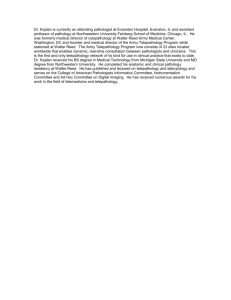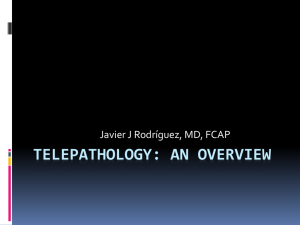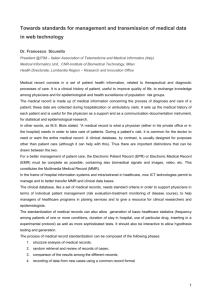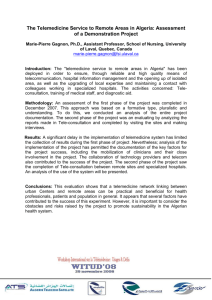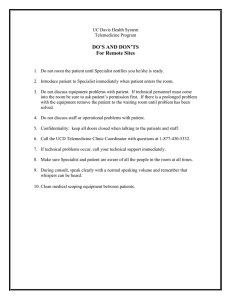iPath-a Telemedicine Platform to Support Health Providers in Low Resource Settings 43
advertisement
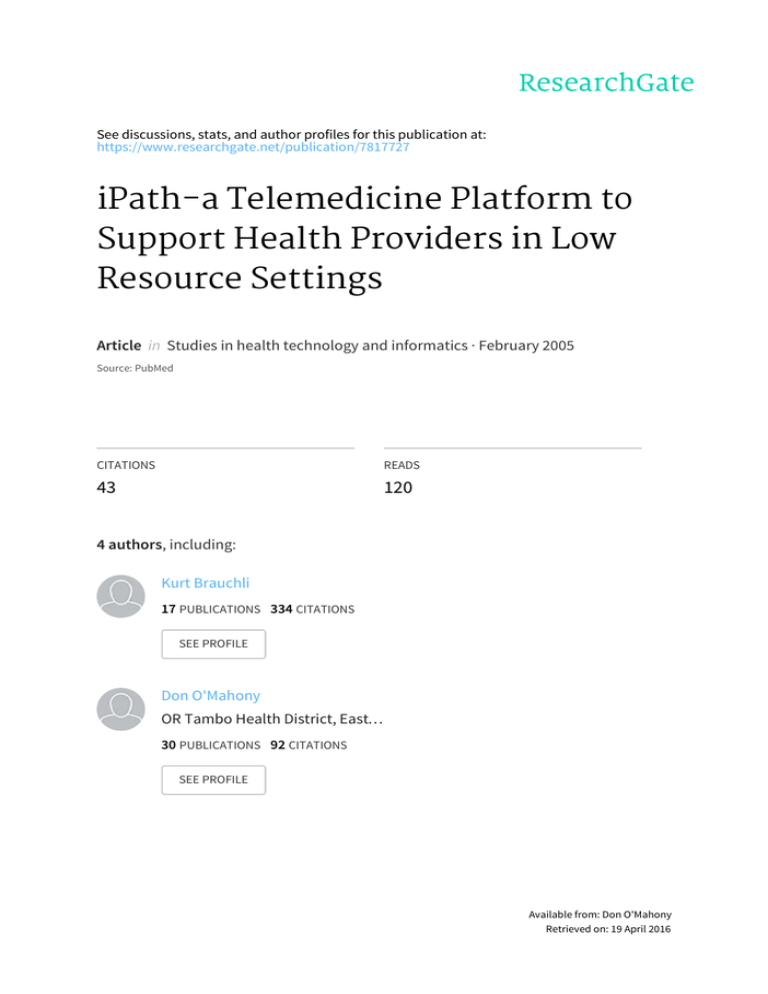
Seediscussions,stats,andauthorprofilesforthispublicationat: https://www.researchgate.net/publication/7817727 iPath-aTelemedicinePlatformto SupportHealthProvidersinLow ResourceSettings ArticleinStudiesinhealthtechnologyandinformatics·February2005 Source:PubMed CITATIONS READS 43 120 4authors,including: KurtBrauchli 17PUBLICATIONS334CITATIONS SEEPROFILE DonO'Mahony ORTamboHealthDistrict,East… 30PUBLICATIONS92CITATIONS SEEPROFILE Availablefrom:DonO'Mahony Retrievedon:19April2016 © The Journal on Information Technology in Healthcare 2005; 3(4): 227–235 iPath: A Telemedicine Platform to Support Health Providers in Low Resource Settings Kurt Brauchli, Don O’Mahony*, Lech Banach† Martin Oberholzer Department of Pathology, University Hospital Basel, Switzerland; *Family Practitioner, Port St. Johns, South Africa; †Telemedicine Unit, University of Transkei, South Africa. ABSTRACT Objective: To evaluate if a user-friendly telemedicine platform was particularly suitable for serving the needs of healthcare workers in low resource settings. Methods: The platform, known as iPath, has been developed as a hybrid Web and e-mail application. Cases can be sent as e-mails with the case title as the subject of the e-mail, the clinical description as the main text and images attached as files. The e-mails are automatically processed by iPath into web pages and imported into a specified user group according to the area of interest of the sender. Pages can then be accessed by members of that group to provide comments and participate in discussion. Members of the group can elect to receive automatic e-mail notification, for example when a new case is entered into a group or a new comment is added to a case. Results: Currently, the main usage of iPath is for the telepathology network at the University of Basel, with over 1,000 users worldwide. From September 2001 to December 2004, 5,016 cases were submitted of which 1,798 were from developing countries. The practicality and attractiveness of the iPath platform for healthcare workers in these countries is demonstrated by the fact that 72% of their cases were submitted by e-mail compared to 32% of all case submissions worldwide. Fourteen developing countries currently use the iPath server in Basel. One of the largest users is the Solomon Islands, which over a two year period has submitted 333 cases. In 50% of submitted cases initial reports have been returned in less than 12 hours. Further improvements in reporting time have been achieved by the creation of a virtual institute with an ‘on call pathologist’ receiving e-mail notification when a new case is submitted. Regional networks have also been established using the iPath platform. One example is a teledermatology project in South Africa where diagnostic assistance to general practitioners has been provided for over 100 cases. Conclusion: iPath is a user-friendly platform that is particularly suitable for supporting healthcare workers in developing countries. The iPath software has been released as an open source project and consequently can be established on local networks and adapted for individual projects worldwide. Correspondence and reprint requests: Dr Kurt Brauchli, Department of Pathology, University Hospital Basel, Switzerland. E-mail: kurt.brauchli@unibas.ch. 227 Brauchli, O’Mahony, Banach & Oberholzer INTRODUCTION Healthcare providers in developing countries often suffer from limited or nonexistent access to specialists1–4. This lack of available specialists means that patients either do not receive appropriate treatment or incur unnecessary expenses and delays in receiving specialist treatment. The development of the Internet has provided a means of making specialist advice available to people in developing countries at low cost. The challenge, however, is ensuring that this can be provided in a user-friendly, efficient manner that serves the needs of the people living in low resource communities. To help achieve this objective, the University of Basel, Switzerland has developed an Internet-based telemedicine platform known as iPath. This paper describes the key features of the system, its practical applications and illustrates its benefits with detailed reports of two projects. SYSTEM DESCRIPTION AND CURRENT USE Since 2001, the Department of Pathology of the University Hospital Basel has been developing the iPath software (ipath.ch). This is an open source framework hybrid Figure 1. A typical case in iPath. An example of a telepathology consultation from Ethiopia. At the top is the general case information (e.g. sender, submission date) followed by a clinical description and an image gallery. At the bottom are the pathologists’ comments and diagnosis. 228 The Journal on Information Technology in Healthcare 2005; 3(4): 227–235 iPath Web- and e-mail-based telemedicine platform5–6. iPath provides the functionality to store medical cases with attached images and other documents into closed user groups (see Figure 1). Within these groups, users can review cases, and write comments and diagnosis. In addition, they can subscribe to receive automatic e-mail notification, for example, when a new comment is added to one of their cases or a new case is entered into a group. Technically, iPath is a Web application written in PHP. PHP is an open source Web language that is widely used as it is especially suited for Web development and can be embedded into HTML (hypertext markup language). From a functional viewpoint, iPath is somewhere between a content management system and a group-ware tool. All users are organised into several discussion groups. Each discussion group has at least one moderator who can assign other users to the group and who can delete erroneous data. Thus, the system does not need to be administered centrally as every group is self-administrating5. A very useful function of iPath, particularly for areas with limited resources is the automatic e-mail import. Users specify a group into which they would like to store cases sent by e-mail and then send cases to iPath as an ordinary e-mail from any e-mail client. When they send the e-mail they type the case title as the subject of the e-mail, the clinical description as the main text and attach images as files. The cases are automatically imported by iPath into the specified group. Table 1 illustrates that of 1,798 cases submitted from developing countries, 74% were submitted by e-mail. This compares to 32% of all case submissions worldwide. The iPath software has been released as an open source project that can be used for regional networks and by other projects. Currently, the main usage of iPath is for the telepathology network at the University of Basel with over 1,000 users worldwide. In addition, we are aware of iPath being used for regional telemedicine networks in South Africa, West Africa, Nepal, Germany, Switzerland and USA. The code is freely available so it is possible that there are other applications that we are unaware of. Telemedicine Platform at University of Basel The Department of Pathology at the University Hospital Basel, Switzerland, has been operating an open telemedicine platform based on iPath – telepath.patho. unibas.ch4–6 – since 2001. When it first started, the platform was mainly used for telepathology projects in Switzerland and for collaboration with a few pathologists in developing countries. Use has gradually expanded so that the platform currently has over 1300 users and to date more than 5000 cases have been discussed (see Table 1). In addition to the pathology projects in our department, the platform is used for other applications including telepathology in the Solomon Islands4 neonatology discussions in Ukraine and teledermatology consultations in Africa. Table 1 shows statistics with respect to basic usage of this platform. By the end of 2004 there were 1,213 users of which 84 specified that they were working in The Journal on Information Technology in Healthcare 2005; 3(4): 227–235 229 Brauchli, O’Mahony, Banach & Oberholzer Table 1. Usage Statistics of iPath (24.12.2004) Total Developing countries Users Cases Images Daily logins (2004) Submission by e-mail 1,213 5,016 33,247* 38 32.12% 1,798 14,006 – 74.17% 84** * average file size 93KB. Besides images there were another 5,864 files (PDF, Powerpoint etc). ** only 47% of users specified country of origin. Figure 2. Consultations submitted from 14 developing countries since the start of the iPath server in Basel in September 2001. Over 60% of the submissions come from telepathology projects in two countries: Cambodia and Solomon Islands. Figure 3. Distribution of image size for consultations submitted to the Basel telepathology server From September 2001 to December 2004 a total amount of 33,247 images with an average file size of 93KB have been submitted. (see Table 1) 230 The Journal on Information Technology in Healthcare 2005; 3(4): 227–235 iPath a developing country. It should, however, be borne in mind that only 47% of all users specified a country of origin, and it is likely that many more users are from developing countries. From the start of the project in September 2001 to the end of December 2004 a total of 5,016 cases with a total of 33,247 images (an average of 6.7 images per case) have been sent to the server. The average image size was 93KB. For developing countries alone, 1,798 cases were submitted with a total of 14,006 images – an average of 7.7 images per case. For the year 2004, developing countries submitted an average of 67 consultations per month. Figure 2 illustrates the origin of these consultations. The largest contribution was from a telepathology project at the Sihanouk Center of Hope in Phnom Penh, Cambodia, which submitted over 700 cases. PROJECTS The practical applications of iPath and its benefits in low resource settings, will be illustrated by describing two projects. Teledermatology in Port St. Johns, South Africa Port St. Johns is a small provincial town located in one of the poorest regions in South Africa. In the rural district of Port St. Johns, the majority of the population, numbering approximately 75,000, live below the poverty line. Primary healthcare is provided mainly by nurses at state funded clinics, supported by general practitioners (GPs) in the public and private sectors. In the last decade, the number of doctors in the district has varied between two and six. The local referral hospital is 100 kilometres away and since 1998 has had no permanent dermatologist. The nearest dermatology specialist is 350 km away. The practical implications of this is that GPs have to diagnose and treat nearly all dermatology problems. These comprise approximately 15% of all consultations. To improve access to dermatological care for patients and to improve GPs’ clinical skills, in April 1999 a teledermatology project was initiated7. The project started with e-mail-based store-and-forward teledermatology, and since 2002 has been using iPath. In the first year, the server in Basel was used. However, in 2003 the Telemedicine Unit district7–8 of the University of Transkei (UNITRA) established its own regional telemedicine network based on the iPath software (telemed.utr.ac.za) and the teledermatology project in Port St. Johns now uses this server. For telemedical consultations, images are captured with a digital camera (initially an Olympus C-1400XL and subsequently a Fujifilm FinePix A201 camera with 2 megapixels resolution) and resized using Adobe Photoshop or GIMP (an acronym for GNU Image Manipulation Program. GIMP is a freely distributed piece of software that can perform such tasks as photo retouching, image composition and image authoring. It works on many operating systems and in many languages). At the beginning of the project, images were submitted by plain e-mail The Journal on Information Technology in Healthcare 2005; 3(4): 227–235 231 Brauchli, O’Mahony, Banach & Oberholzer with attached pictures. However, text and pictures easily got separated and misfiled. To prevent this problem, it was decided to compile information and images into an HTML (hypertext markup language) page. This worked well but was a very time consuming process. The development of iPath has helped to address this problem. Clinical information and images are now sent by plain e-mail to the iPath server which automatically processes them and inserts them into a database in the form of a concise web page. The system’s ease of use and additional features such as automatic e-mail notification have been important in reducing the turnaround time for consultations. At UNITRA, as a result of using iPath, the average response time for consultations has fallen from over 30 days to just 6.5 days. Since 1999, 110 patients from Port St. Johns have been diagnosed using teledermatology. 76 patients were female and 34 male with an average age of 32 years. In 105 cases, a telemedical diagnosis was possible and in 104 cases this assistance was judged helpful by the GP. For 57 of these cases, the telemedical diagnosis enabled an improvement in patient treatment. In addition to the patient benefits, teledermatology also helped GPs to improve their skills in diagnosing and treating dermatology problems. This is demonstrated by one GP who confirmed that the number of cases he refers has dropped off over the years due to his improved diagnostic skills as a result of the Teledermatology program. Telepathology on Solomon Islands Solomon Islands is an independent state in the Pacific Ocean with approximately 450,000 inhabitants. The National Referral Hospital (NRH) in Honiara is the only major hospital, and acts as a referral hospital for eight provincial hospitals. None of the hospitals, however, has a pathologist and to obtain histological studies, tissue samples have to be sent by airmail to Brisbane in Australia. Reports usually take 3–6 weeks to be returned. The Solomon Islands consist of over 900 islands, spread out over hundreds of kilometres. To obtain medical advice and treatment, patients from remote islands may have to travel by boat for days to reach the hospital on the main island. Inevitably, for a number of reasons they may not be able to wait weeks on the main island until a histological diagnosis can be confirmed. As a consequence, treatment decisions often have to be made without a histological diagnosis. To address this problem, a small histology laboratory was established at the NRH in September 2001. Staff in the hospital are able to prepare Haematoxylin and Eosin (H&E) stained sections. Gross specimens are prepared by the surgeon, processed in the laboratory and the slides are usually ready two or three days later. From the microscopic sections prepared in this laboratory, digital photographs are taken using a Nikon CoolPix 990 camera mounted on a Nikon OptiPhot 2 microscope. The pictures are usually scaled to approximately 600 × 400 pixels (typically 20KB–70KB) and sent via e-mail to the telepathology server at the University of Basel4. 232 The Journal on Information Technology in Healthcare 2005; 3(4): 227–235 iPath Table 2. Telepathology Consultations from National Referral Hospital in Honiara, Solomon Islands Phase I refers to consultations before the introduction of the virtual institute (see text) and covers the period from January 2002 to October 2002. Phase II describes the situation after the introduction of the virtual institute from November 2002 to December 2003. The second line indicates the median time between submission of the case by e-mail and the first response from a pathologist. (Figures from Brauchli et al. 2004.) Number of consultations Time to first response (median) Consultation possible Additional images requested Phase I Phase II Total 73 28h 93.2% 24.7% 260 8.5h 94.2% 10% 333 12h (average) 94% 13.2% From January 2002 to December 2003, a total of 333 pathology consultations were submitted by e-mail with a short clinical description as text and images sent as attachments (average 8.8 images per consultation). In 50% of all consultations a first report from a pathologist was issued in 12 hours or less (see Table 2). A major improvement in the project was the introduction of a virtual institute4–6. A virtual institute is a group of experts with a duty plan. Every week one specialist is ‘on call’ and the iPath system automatically notifies him or her about any new cases and also about new comments from colleagues. The expert on call will write a diagnosis and mark it as final if in his or her opinion, a diagnostically conclusive response is possible based on the submitted material. Otherwise, the expert on call will refer the case to the whole expert group and all experts will give their opinion. The expert on call will then write a summary of the comments from the expert group. These arrangements helped to reduce the turn around time for diagnosis from 28 hours (Phase I in Table 2) to 8.5 hours after the introduction of the virtual institute (Phase II). DISCUSSION Developments in information and communication technology (ICT) have made it possible to provide specialist advice to people in low resource settings at low cost. Despite this ability, the challenge still remains of how to provide it in a user-friendly way that meets local needs. When iPath was developed it was not primarily intended for telemedicine in low resource settings. However, as an easy to use telemedicine solution that does not require high bandwidth it is an attractive tool for developing countries. The ability to simply send cases as e-mails and have them automatically processed into web pages is a particularly attractive feature for healthcare workers in low resource settings. This is evidenced by both the high number of cases sent from developing The Journal on Information Technology in Healthcare 2005; 3(4): 227–235 233 Brauchli, O’Mahony, Banach & Oberholzer countries (1,798 with a total of 14,006 images over a period of just over 3 years) and the high percentage of these cases submitted as e-mails (74% of the cases submitted from developing countries compared to 32% of cases worldwide). Besides its ease of use, iPath has demonstrated its ability to meet the needs of healthcare workers in low resource settings. The telepathology service to the Solomon Islands currently returns 50% of reports in less than 12 hrs. This compares very favourably to the 3–6 weeks that it takes for reports to be returned when specimens are sent by airmail to Australia. Significant cost savings will also be achieved from the telepathology service compared to the airmail service. Following the success of telepathology in Solomon islands, we extended the telepathology service to other countries and now receive approximately 70 consultations each month from developing countries. We have also broadened the service to include teledermatology projects in Africa using this platform and a large project for neonatology consultations in Ukraine. In all these examples, telemedicine is not used directly by the patient but primarily by doctors and nurses who need the additional input from specialists to improve the services that they are delivering. iPath has enabled them to overcome the professional isolation they often face in remote areas and to improve their skill and services they can deliver to their patients. An attractive feature of iPath is that it has been developed as an open source project and is distributed under the General Public License (GPL). The open source license allows other projects to use iPath and adapt it to their needs. As telemedicine is primarily used by specialists in centrally located institutions, it bears the risk of inducing a digital divide within a developing country if the periphery of the health system is not involved in the development of the network9. There are also often cultural differences and language barriers that are difficult to address in large international projects. The open source nature of iPath allows such adaptations and makes it possible to easily reproduce working regional solutions. As iPath has developed, over the past three years we have observed a number of different types of applications. • Remote consultations where typically a doctor in a low resource setting consults with a group of distant specialists. • General discussion groups where specialists working in isolation share knowledge and experience with distant colleagues. • Use of data for decentralised studies. The data can be text, images or even customised forms for capturing structured data. The advantage of an Internet based solution is that anybody can at any time review the whole collection and compile statistics. It is hoped that in the future iPath will continue to develop its applications and ability to serve the needs of healthcare workers in developing countries, and also as a research tool due to the large amount of readily accessible data stored within it. 234 The Journal on Information Technology in Healthcare 2005; 3(4): 227–235 iPath REFERENCES 1 Fraser HS, McGrath SJ. Information technology and telemedicine in sub-saharan Africa. BMJ 2000; 321: 465–66. 2 Johnston K, Kennedy C, Murdoch I, Taylor P, Cook C. The cost-effectiveness of technology transfer using telemedicine. Health Policy Plan 2004; 19: 302–9. 3 Schmid-Grendelmeier P, Doe P, Pakenham-Walsh N. Teledermatology in sub-Saharan Africa. Curr Probl Dermatol 2003; 32: 233–46. 4 Brauchli K, Jagilly R, Oberli H, Kunze KD, Phillips G, Hurwitz N, Oberholzer M. Telepathology on the Solomon Islands: two years’ experience with a hybrid Web- and email-based telepathology system. J Telemed Telecare 2004; 10(Suppl 1): 14–17. 5 Brauchli K, Christen H, Haroske G, Meyer W, Kunze KD, Oberholzer M. Telemicroscopy by the Internet revisited. J Pathol 2002; 196: 238–43. 6 Brauchli K, Oberli H, Hurwitz N, et al. Diagnostic telepathology: long-term experience of a single institution. Virchows Arch 2004; 444: 403–9. 7 O’Mahony D, Banach L, Mahapa DH et al. Teledermatology in a rural family practice. S A Fam Pract 2002; 25: 4–8. 8 Stepien A, Banach L, Chibowski D, Korobowicz E, Wronecki L, Sobolewska E. Histo- and cytopathologic remote diagnosis (telepathology). Preliminary report. Ann Univ Mariae Curie Sklodowska [Med] 1999; 54: 313–18. 9 Geissbuhler A, Ly O, Lovis C, L’Haire JF. Telemedicine in Western Africa: lessons learned from a pilot project in Mali, perspectives and recommendations. AMIA Annu Symp Proc, 2003, pp. 249–53. © The Journal on Information Technology in Healthcare 2005; 3(4): 227–235 235
